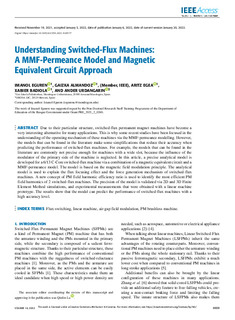| dc.rights.license | Attribution 4.0 International | * |
| dc.contributor.author | Eguren-Alustiza, Imanol | |
| dc.contributor.author | Almandoz, Gaizka | |
| dc.contributor.author | Egea, Aritz | |
| dc.contributor.author | Badiola, Xabier | |
| dc.contributor.other | Urdangarin Lasa, Ander | |
| dc.date.accessioned | 2022-02-16T13:50:48Z | |
| dc.date.available | 2022-02-16T13:50:48Z | |
| dc.date.issued | 2022 | |
| dc.identifier.issn | 2169-3536 | en |
| dc.identifier.other | https://katalogoa.mondragon.edu/janium-bin/janium_login_opac.pl?find&ficha_no=167033 | en |
| dc.identifier.uri | https://hdl.handle.net/20.500.11984/5470 | |
| dc.description.abstract | Due to their particular structure, switched-flux permanent magnet machines have become a very interesting alternative for many applications. This is why some recent studies have been focused in the understanding of the operating mechanism of these machines via the MMF-permeance modelling. However, the models that can be found in the literature make some simplifications that reduce their accuracy when predicting the performance of switched-flux machines. For example, the models that can be found in the literature are commonly not precise enough for machines with a wide slot, because the influence of the modulator of the primary side of the machine is neglected. In this article, a precise analytical model is developed for a 6/13 C-Core switched-flux machine via a combination of a magnetic equivalent circuit and a MMF-permeance model. The model is based on the magnetic field modulation principle. The analytical model is used to explain the flux focusing effect and the force generation mechanism of switched-flux machines. A new concept of PM field harmonic efficiency ratio is used to identify the most efficient PM field harmonics of 2 switched-flux machines. The precision of the model is validated via 2D and 3D Finite Element Method simulations, and experimental measurements that were obtained with a linear machine prototype. The results show that the model can predict the performance of switched-flux machines with a high accuracy level. | en |
| dc.description.sponsorship | Gobierno Vasco | es |
| dc.language.iso | eng | en |
| dc.publisher | IEEE | en |
| dc.rights | © 2022 The authors | en |
| dc.rights.uri | http://creativecommons.org/licenses/by/4.0/ | * |
| dc.subject | Flux-switching | en |
| dc.subject | linear machine | en |
| dc.subject | air-gap field modulation | en |
| dc.subject | PM brushless machine | en |
| dc.title | Understanding Switched-Flux Machines: A MMF-Permeance Model and Magnetic Equivalent Circuit Approach | en |
| dcterms.accessRights | http://purl.org/coar/access_right/c_abf2 | en |
| dcterms.source | IEEE Access | en |
| local.contributor.group | Accionamientos aplicados a la tracción y a la generación de energía eléctrica | es |
| local.description.peerreviewed | true | en |
| local.description.publicationfirstpage | 6909 | en |
| local.description.publicationlastpage | 6928 | en |
| local.identifier.doi | https://doi.org/10.1109/ACCESS.2022.3140977 | en |
| local.relation.projectID | info:eu-repo/grantAgreement/GV/Programa predoctoral de formación del personal investigador no doctor 2021-2022/PRE_2021_2_0240/CAPV// | en |
| local.rights.publicationfee | APC | en |
| local.rights.publicationfeeamount | 1750 EUR | en |
| local.contributor.otherinstitution | Orona EIC | es |
| local.source.details | Vol. 10. Pp. 6909 - 6928, 2022 | en |
| oaire.format.mimetype | application/pdf | |
| oaire.file | $DSPACE\assetstore | |
| oaire.resourceType | http://purl.org/coar/resource_type/c_6501 | en |
| oaire.version | http://purl.org/coar/version/c_970fb48d4fbd8a85 | en |








